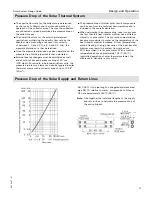
Solar System Design Guide
63
6020 457 - 01
Heat rejection units
In cases where the DHW load is very intermittent or much
lower during the summer months, some type of mechanical
heat rejection unit in the solar loop must be used to minimize
collector stagnation and glycol degradation. The heat rejection
unit can take the form of a hydronic fan coil unit, finned tube
radiators, or a ground loop. The rejection unit should be sized
based on the maximum possible output of the solar collector
array and all parts of the rejection loop must be rated for
temperatures of at least 200°F (95°C). For Vitosol collectors
it is recommended to size the rejection unit at 225 Btu/h
per ft
2
(700 W/m
2
) of collector aperture area. The control
of the heat rejection circuit should be based on the collector
temperature sensor, and activated by the solar controller.
Solar storage tank requirements
Fossil fuel fired DHW heaters can turn on and heat water
when there is a demand, and off when there is not. Solar
water heaters however must collect energy when the
insolation is available, and store the energy for when
there is a demand. The period of heat generation and the
period of consumption are rarely the same, so having
sufficient solar storage tank capacity is essential for
the efficient operation of the solar system. Insufficient
storage capacity will lead to higher temperatures in
the collector loop, resulting in low collector efficiency,
reduced system yields and collector stagnation. In almost
all cases more storage volume equals better system
efficiency. The amount of storage required is based on
the type of solar application and the size of the collector
array. The following can be used as a guideline for
selecting the solar storage tank requirements:
Solar storage
requirements based on
collector aperture area
Type of solar application:
DHW heating with high
usage rate and low
Solar Fraction (commercial)
DHW heating with low
usage rate and high
Solar Fraction (residential)
Combi systems, DHW +
space heating supplement
(both)
USG / ft
2
(L/m
2
)
0.85 - 1.23
(35 - 50)
1.23 - 1.60
(50 - 65)
1.72 - 2.45
(70 - 100)
Maximum Number of Solar Collectors per Vitocell Tank
Tank Model
Maximum number of Vitosol 200-FM
*Based on 50 L/m2 of tank volume
Single Coil Vitocell Tank Models
1x Vitocell 300-W, EVIA 42 USG (160 L)
1
1x Vitocell 300-V, EVIA 53 USG (200 L)
1 to 2
1x Vitocell 300-V, EVIA 79 USG (300 L)
2 to 3
1x Vitocell 300-V, EVIB 119 USG (450 L)
4 to 5
Dual Coil Vitocell Tank Models (Top coil used for DHW backup via boiler)
1x Vitocell 300-B, EVBA 79 USG (300 L)
1 to 2
1x Vitocell 300-B, EVBB 119 USG (450 L)
2 to 3
Note:
When using Vitocell dual coil storage tanks where
the top coil is not connected to a backup heat generator,
the maximum number of collectors allowed can be
increased to match that of single coil tanks.
Sizing the Solar Thermal System
(continued)
Design and Operation
















































